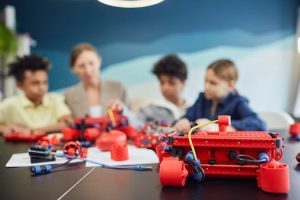EdTech Integration: Beyond Substitution to Transformation
Welcome to the digital era where technology has become an integral part of our daily lives, including the education sector. The rise of educational technology, or EdTech, has drastically transformed the way students learn and teachers teach. From online learning platforms to interactive apps and virtual reality tools, the possibilities are endless. However, the true value of EdTech lies not in its substitution for traditional teaching methods, but in its potential to transform and enhance the learning experience. In this article, we will explore the concept of EdTech integration and how it goes beyond mere substitution to bring about a true transformation in education.
The Difference Between Substitution and Transformation
To truly understand the impact of EdTech integration, we must first distinguish between substitution and transformation. Substitution refers to using technology as a direct replacement for traditional teaching methods. For example, using a digital textbook instead of a physical one or an online quiz instead of a paper-and-pencil one. While this does bring about some convenience and efficiency, it does not significantly enhance the learning experience.
On the other hand, transformation involves using technology to create new and innovative learning experiences that were not possible before. This could include interactive simulations, virtual field trips, and personalized learning apps. Such approaches not only engage students but also cater to their individual needs and learning styles.
The Benefits of EdTech Integration
Increased Engagement and Collaboration
Gone are the days of passive learning where students were limited to textbooks and lectures. EdTech tools offer an interactive and immersive learning experience that keeps students engaged and motivated. Whether it’s through gamification, virtual reality, or collaborative online platforms, students can actively participate in their learning, making it more meaningful and enjoyable.
Moreover, EdTech also promotes collaboration among students, both in and out of the classroom. Online platforms and tools make it easier for students to share ideas, collaborate on projects, and receive feedback from their peers and teachers. This not only enhances their teamwork skills but also allows them to learn from one another.
Personalized Learning Opportunities
Every student has his or her unique abilities, needs, and learning style. EdTech tools can cater to these individual differences by providing personalized learning experiences. For instance, adaptive learning programs can assess a student’s strengths and weaknesses and deliver content that is tailored to their needs. This not only helps students learn at their own pace but also ensures that they receive the support they need to flourish academically.
Improved Teacher-Student Communication
EdTech has not only brought about changes in student learning but also in teacher-student communication. With the use of online learning platforms and tools, teachers can interact with their students beyond the traditional classroom setting. This allows for more effective and timely feedback, making the learning process more efficient. Students can also reach out to their teachers for clarification or assistance whenever needed, fostering a more collaborative and supportive learning environment.
Overcoming Barriers to EdTech Integration
While EdTech integration has numerous benefits, it is not without its challenges. Some of the common barriers to its effective adoption include insufficient resources, lack of training, and resistance to change. However, with proper planning, support, and continuous professional development for teachers, these barriers can be overcome to bring about a successful and meaningful EdTech integration.
The Role of Teachers and Schools in EdTech Integration
Teachers play a crucial role in EdTech integration as they are the ones who facilitate the learning process. It is essential for them to understand the potential of EdTech tools and be willing to incorporate them into their teaching strategies. Schools also play an important role in providing the necessary resources, support, and infrastructure for effective EdTech integration. By working together, teachers and schools can bring about a transformation in education and prepare students for the digital world ahead.
Conclusion
EdTech integration is not just about using technology in classrooms; it is about creating new and innovative learning experiences that enhance the learning process. By going beyond substitution to transformation, we can provide students with the skills and knowledge they need to thrive in the digital age. However, it is essential to remember that EdTech should not replace traditional teaching methods, but rather complement and enhance them. With the right approach and mindset, EdTech can truly transform education and prepare students for a dynamic and technology-driven future.










